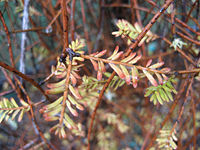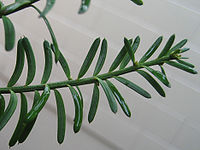
Prumnopitys taxifolia
Encyclopedia
Prumnopitys taxifolia (Mataī or Black pine) is an endemic
New Zealand
coniferous tree that grows on the North Island
and South Island
. It also occurs on Stewart Island/Rakiura
(47 °S) but is uncommon there.
It grows up to 40 m high, with a trunk up to 2 m diameter. The leaves
are linear to sickle-shaped, 10–15 mm long and 1.5–2 mm broad. The seed cones
are highly modified, reduced to a central stem 3–4 cm long bearing 1-6 scales, each scale maturing berry-like, 10–15 mm long, violet-purple with a soft edible pulp covering the single seed
. The seeds are dispersed by the Kererū
(New Zealand Pigeon), which eats the 'berries' and passes the seeds in its droppings.
(Taxus). In the past the species, like the other species of Prumnopitys
, was often included in Podocarpus
; in this species under the name Podocarpus spicatus. It is distinguished from Miro by the shorter, more slender leaves and the globose violet-purple cones.
 Unlike the related Miro
Unlike the related Miro
(Prumnopitys ferruginea), Mataī has a distinctive and long-lasting juvenile stage. The juvenile is a shrub with a tangle of slender, flexible, divaricating branchlets interspersed with a scattering of brown, pale yellow, or dirty white leaves. After a number of years, the adult tree begins to grow out of the top of the juvenile shrub and then the divaricating branchlets will wither and drop off.
 The timber
The timber
of this tree was used extensively in New Zealand for flooring
during the mid-20th century. Mataī is not threatened, although as a forest-type it has been greatly reduced through widespread logging. Very few intact examples of Mataī-dominated forest remain.
Endemic (ecology)
Endemism is the ecological state of being unique to a defined geographic location, such as an island, nation or other defined zone, or habitat type; organisms that are indigenous to a place are not endemic to it if they are also found elsewhere. For example, all species of lemur are endemic to the...
New Zealand
New Zealand
New Zealand is an island country in the south-western Pacific Ocean comprising two main landmasses and numerous smaller islands. The country is situated some east of Australia across the Tasman Sea, and roughly south of the Pacific island nations of New Caledonia, Fiji, and Tonga...
coniferous tree that grows on the North Island
North Island
The North Island is one of the two main islands of New Zealand, separated from the much less populous South Island by Cook Strait. The island is in area, making it the world's 14th-largest island...
and South Island
South Island
The South Island is the larger of the two major islands of New Zealand, the other being the more populous North Island. It is bordered to the north by Cook Strait, to the west by the Tasman Sea, to the south and east by the Pacific Ocean...
. It also occurs on Stewart Island/Rakiura
Stewart Island/Rakiura
Stewart Island/Rakiura is the third-largest island of New Zealand. It lies south of the South Island, across Foveaux Strait. Its permanent population is slightly over 400 people, most of whom live in the settlement of Oban.- History and naming :...
(47 °S) but is uncommon there.
It grows up to 40 m high, with a trunk up to 2 m diameter. The leaves
Leaf
A leaf is an organ of a vascular plant, as defined in botanical terms, and in particular in plant morphology. Foliage is a mass noun that refers to leaves as a feature of plants....
are linear to sickle-shaped, 10–15 mm long and 1.5–2 mm broad. The seed cones
Conifer cone
A cone is an organ on plants in the division Pinophyta that contains the reproductive structures. The familiar woody cone is the female cone, which produces seeds. The male cones, which produce pollen, are usually herbaceous and much less conspicuous even at full maturity...
are highly modified, reduced to a central stem 3–4 cm long bearing 1-6 scales, each scale maturing berry-like, 10–15 mm long, violet-purple with a soft edible pulp covering the single seed
Seed
A seed is a small embryonic plant enclosed in a covering called the seed coat, usually with some stored food. It is the product of the ripened ovule of gymnosperm and angiosperm plants which occurs after fertilization and some growth within the mother plant...
. The seeds are dispersed by the Kererū
Kereru
The New Zealand Pigeon or kererū is a bird endemic to New Zealand. Māori call it Kererū in most of the country but kūkupa and kūkū in some parts of the North Island, particularly in Northland...
(New Zealand Pigeon), which eats the 'berries' and passes the seeds in its droppings.
Classification
The scientific name taxifolia derives from the resemblance of the leaves to those of the yewTaxus
Taxus is a genus of yews, small coniferous trees or shrubs in the yew family Taxaceae. They are relatively slow-growing and can be very long-lived, and reach heights of 1-40 m, with trunk diameters of up to 4 m...
(Taxus). In the past the species, like the other species of Prumnopitys
Prumnopitys
Prumnopitys is a genus of conifers belonging to the podocarp family Podocarpaceae. The eight recognised species of Prumnopitys are densely-branched, dioecious evergreen trees up to 40 metres in height. The leaves are similar to those of the yew, strap-shaped, 1-4 cm long and 2-3 mm broad, with a...
, was often included in Podocarpus
Podocarpus
Podocarpus is a genus of conifers, the most numerous and widely distributed of the podocarp family Podocarpaceae. The 105 species of Podocarpus are evergreen shrubs or trees from 1-25 m in height...
; in this species under the name Podocarpus spicatus. It is distinguished from Miro by the shorter, more slender leaves and the globose violet-purple cones.
Juvenile stage

Prumnopitys ferruginea
Prumnopitys ferruginea is an evergreen coniferous tree which is endemic to New Zealand. Before the genus Prumnopitys was distinguished, it was treated in the related genus Podocarpus as Podocarpus ferrugineus....
(Prumnopitys ferruginea), Mataī has a distinctive and long-lasting juvenile stage. The juvenile is a shrub with a tangle of slender, flexible, divaricating branchlets interspersed with a scattering of brown, pale yellow, or dirty white leaves. After a number of years, the adult tree begins to grow out of the top of the juvenile shrub and then the divaricating branchlets will wither and drop off.
Use

Timber
Timber may refer to:* Timber, a term common in the United Kingdom and Australia for wood materials * Timber, Oregon, an unincorporated community in the U.S...
of this tree was used extensively in New Zealand for flooring
Parquetry
Parquetry is a geometric mosaic of wood pieces used for decorative effect. The two main uses of parquetry are as veneer patterns on furniture and block patterns for flooring. Parquet patterns are entirely geometrical and angular—squares, triangles, lozenges. The most popular parquet flooring...
during the mid-20th century. Mataī is not threatened, although as a forest-type it has been greatly reduced through widespread logging. Very few intact examples of Mataī-dominated forest remain.

